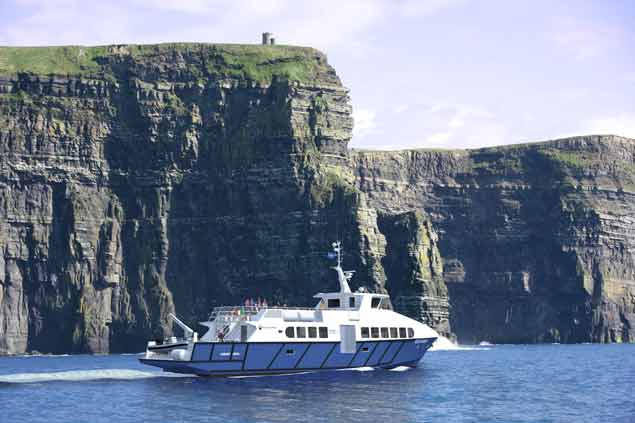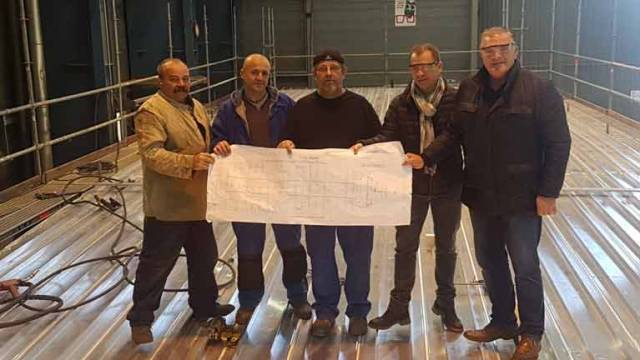Accessing Ireland’s most popular offshore destination, the Aran Islands, and the Cliffs of Moher by sea is to get a lot more comfortable, faster and environmentally friendly thanks to a record investment by one of the best known sea faring families on the west coast.
In what will be the biggest single private transport infrastructure investment on the Wild Atlantic Way, the Garrihy family run business, Doolin2Aran Ferries, has commissioned a state of the art, €3m new vessel that is being built by OCEA Shipbuilding in La Rochelle, France. This is the first ship to be built for the popular port of Doolin this decade, the last one being the Doolin Discovery, which was also commissioned by the Garrihy family in 2009.
Doolin2Aran Ferries is owned and operated by the Garrihy family from Doolin, who have been operating commercially on the seas around Doolin for half a century.
 An artist’s impression of the new 26m Doolin to Aran Ferries cruise ship being built in France
An artist’s impression of the new 26m Doolin to Aran Ferries cruise ship being built in France
The 26–metre vessel will be the fastest and most comfortable domestic cruise ship on the entire Irish coast. It will operate daily sailings to the Aran Islands as well as the stunning cruise to the foot of the Cliffs of Moher, one of the West coast’s most captivating tourism experiences.
The one-off designed cruise ship will also be tailored for international tourists, with multi-lingual voice and visual guide systems to ensure visitors get the absolute experience and knowledge of the world-famous heritage sites.
In production since late October, the 200-seat vessel will have the highest specification available. It will incorporate system built seating and air conditioning, and the most advanced computerised stability system providing quality and comfort to passengers.
The ship also embraces the latest in terms of environmentally friendly technologies with a high-tech, on-board waste water treatment plant and TIER ii advanced low emission energy efficient engines.
The shipbuilders, OCEA, are one of Europe’s leading specialist manufacturers of ships for the leisure and commercial markets. Building up to 20 vessels per year, and for some of the world’s most high net-worth individuals, OCEA operates across four production sites, with 95% of its turnover garnered from the export markets. Its biggest build to date is an €80m patrol boat for a Middle Eastern client.
On completion, the Doolin2Aran Ferries vessel will be sailed back from La Rochelle, with stops in Brest in North West France before making its way to Doolin where it will join the fleet of Doolin2Aran Ferries vessels, helping to accommodate the huge increase in popularity of cruises to the islands and the Cliffs of Moher since the launch of the Wild Atlantic Way brand. It will be the largest operator sailing out of the hugely popular Aran Islands gateway pier. The Garrihy family also own and operate The Happy Hooker, The Rose of Aran, The Jack B, The Doolin Discovery and the St Bridget, which operates on Dublin Bay.
Commenting on the investment, Eugene Garrihy of Doolin2Aran Ferries said: “We worked hard to get the new improved pier facilities at Doolin and now we are investing in this state of the art vessel. We have grown the business year on year and we feel the time is right to take our business to a new level with this investment. The Wild Atlantic Way is proving a global tourism phenomenon and we have to respond in the industry by improving the quality of our offering to ever more discerning customers.
“With good visitor management and continued engagement with all tourism bodies, we are confident that the impact of this investment in the region will be very positive. The ship will be the largest and fastest operating to the islands from Doolin. As it will operate in the UNESCO Burren and Cliffs of Moher Geopark, we were also particularly conscious that it would be the most energy efficient and sustainable vessel operating here and is being custom built to that end.
“We’re really looking forward to its completion and getting it back here. There’ll be nothing like it for tourists heading out from the west coast.”
































































